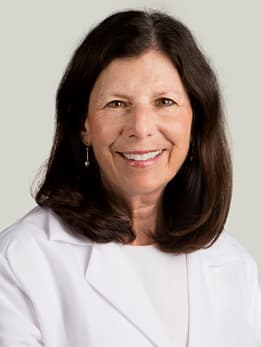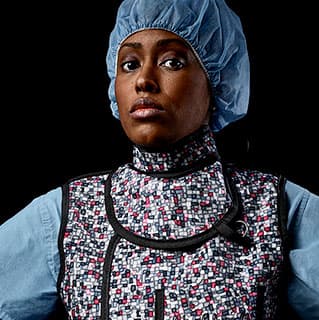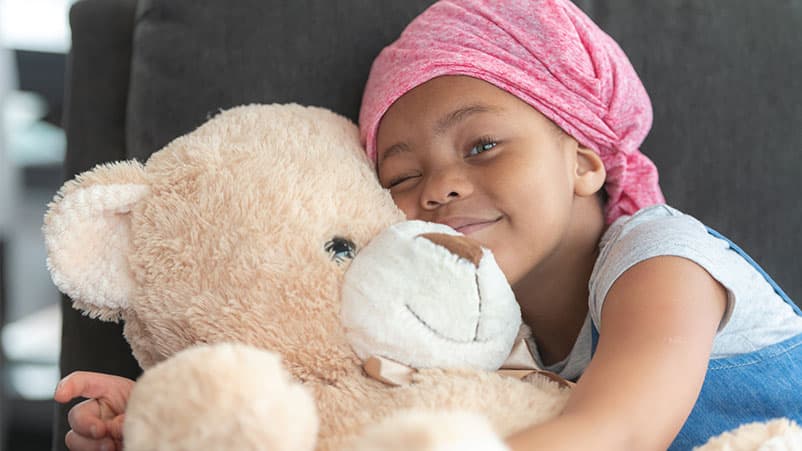Susan Cohn, MD: An unwavering dedication to helping children with neuroblastoma

Susan Cohn was in her pediatric residency at Michael Reese Hospital in 1984 when she met Emily, a lively 4-year-old girl who was diagnosed with a rare pediatric cancer called neuroblastoma.
“Emily was just so precocious and so bright and so smart and so funny,” Cohn said. “Despite using the best treatments available, I saw her tumor continue to grow and I saw her get sick and I saw her die.”
That’s when Cohn made the decision to dedicate her career to researching and treating neuroblastoma, a cancer of peripheral nerve cells that typically affects young children by age 5 and is often found in the abdomen, but can also be located in the neck, chest or pelvis.
“I started thinking about what I could do to make this better and improve the outcome so that little children like Emily didn’t have to die,” said Cohn, now director of clinical research in the Department of Pediatrics at the University of Chicago.
Neuroblastoma accounts for about 6% of all cancers in children, with the average age of diagnosis at 1 to 2 years old, according to the American Cancer Society. Only about 800 new cases are diagnosed in the United States each year.
When Cohn met Emily, it was early in neuroblastoma research, when the survival rate for children with high-risk neuroblastoma was barely more than 20%.
Nearly four decades later, the five-year survival rate for neuroblastoma is 60%, and Cohn has become internationally recognized for her work in managing and treating the disease. From her leadership in clinical trials and risk stratification to her laboratory work on the molecular underpinnings of aggressive, high-risk neuroblastoma, Cohn has helped make significant advancements in more effective, targeted treatments and the way neuroblastoma is managed.
Only lead-lined patient room in Illinois
Among the most visible of her accomplishments is the meta-iodobenzylguanidine (MIBG) treatment program — including a patient room lined with 45,000 pounds of lead brick — that she and her team established at the University of Chicago Medicine’s Comer Children’s Hospital in April 2014 for relapsed neuroblastoma and other difficult-to-treat cancers. Comer Children’s is the only place in Illinois and one of about a dozen across the country equipped to administer the advanced MIBG therapy, which requires a highly specialized care team and a dedicated lead-lined patient room designed to minimize radiation exposure to families, other patients and staff.
MIBG is a molecule that is actively absorbed by neuroblastoma cells. ('Neuro' refers to nerves, and 'blastoma' refers to a type of cancer that affects immature/developing cells.) Radioactive iodine is attached to MIBG and administered to the patient intravenously. MIBG carries the radioactive iodine directly to neuroblastoma cells, killing the tumor cells. After the radiation reaches the tumor, it leaves the child's body through bodily fluids (e.g., urine, saliva, skin secretions) over the course of a few days.
“The child must be hospitalized and remain in bed with a catheter to collect urine during this time period, which typically takes three to five days,” Cohn said.
Patients are treated in a lead-lined room due to high levels of radiation. To help pass the time and stay connected, children often play games like bingo over a closed-circuit TV channel and communicate via walkie-talkie with their parents, who have only limited visitation in the room until radiation levels fall.
As we discover more about the biology of neuroblastoma and what we need to target, I think we will come up new and better treatments that will continue to push the cure curve upwards. I’m convinced.
This targeted radiotherapy has been shown to be one of the most active treatments for children with neuroblastoma that has not responded to standard therapy. Based on the high response rate observed in children with relapsed disease, MIBG is now being tested in a randomized phase 3 study in newly diagnosed children with high-risk neuroblastoma.
"MIBG is one of the most effective therapies available with a response rate of about 30%," said Cohn. "We've developed an outstanding care team here at Comer Children's Hospital with expertise in neuroblastoma, nuclear medicine and radiation safety. We're pleased to have the facilities in place to provide every effective modality of treatment so that families do not need to travel away from Chicago to receive MIBG or other leading-edge therapies."
Cohn's multidisciplinary team includes oncologists, advanced practice nurses, nuclear medicine physicians and technicians, radiation safety experts, radio-pharmacists, child life specialists and social workers all focused on providing comprehensive medical care, safety and support for patients and their families.
It is that kind of innovative thinking and teamwork that benefits patients who are treated at UChicago Medicine.
Dedication to a cure
The Herzog family met Cohn after a nearly three-year search for a cure for Carson, their youngest son. His pediatrician initially thought Carson, then 3 months old, had epilepsy triggered by an ear infection. But his condition worsened. Carson began to lose control of his muscles at 11 months old. At age 2, he had generalized tonic-clonic (grand mal) seizures.
His parents knew something more had to be done.
His mom, Jessica Herzog, made an appointment with pediatric neurologist Chalongchai Phitsanuwong, MD, an epilepsy expert at Comer Children’s who brought in Cohn to help get to the bottom of his symptoms.
Carson's care team decided to test him for paraneoplastic syndrome, another rare condition that affects the nervous system due to an immunologic response to a malignancy. Cohn ordered a full-body CT scan to look for the potential cause of the neurologic symptoms.
Everyone in the room gasped when they saw a tumor in Carson’s lungs.
“At almost 3 years old, we finally found a diagnosis, and it was solely because the team at Comer listened to us and truly cared about him,” said Jessica.
Following surgery and treatment with corticosteroids and intravenous immunoglobulin (IVIG), which uses human antibodies found in plasma cells to fight disease or infections, Carson’s symptoms improved. He is now a happy 3-year-old who loves running and building blocks.
“We can go to the park again,” Herzog said. “Before we would have to leave because Carson would have an episode or fall over, and now we just get to enjoy time together. It’s the greatest gift.”
Cohn continues her work in this area through the first clinical trials to study IVIG with prednisone and risk-adapted chemotherapy for children with OMA-associated with neuroblastoma.
Laying the foundation for the future of research
Through Cohn’s appointment as the inaugural director of faculty scholars program in the UChicago’s Department of Pediatrics, Cohn can fulfill another one of her passions: developing the academic careers of young faculty who are interested in conducting clinical research to improve the outcomes of young patients.
This is an expansion of the work that Cohn has performed for over a decade mentoring clinical investigators, such as pediatric oncologist Samuel Volchenboum, MD, PhD.
“In many ways, my career has been impacted by Dr. Cohn,” Volchenboum said.
Cohn and Volchenboum used to live just three blocks away from each other decades ago. While they didn’t know each other at the time, they would come to collaborate on a game changer in pediatric cancer research: the Pediatric Cancer Data Commons (PCDC).
The PCDC is an ecosystem that houses clinical information and other types of data from children with many types of cancer, including neuroblastoma. Access to big data is often the catalyst for innovation and discovery; however, when working in rare pediatric cancers, big data can be hard to come by.
Historically, these data were kept in disparate spreadsheets across the globe. In 2005, Cohn co-led an effort with Andrew Pearson, MD, from the United Kingdom to collect clinical data from children from around the world who were diagnosed with neuroblastoma. In 2012, Cohn and Volchenboum started working together to systemize and expand the data collection and its access.
Today, the PCDC has grown to facilitate the connection and aggregation of multiple types of data into a single cloud-based environment that can be made accessible to anyone around the world.
As of today, the PCDC has information on more than 22,000 pediatric patients with neuroblastoma, as well as data from children with other types of pediatric cancers, including soft tissue sarcoma and leukemia. These data are available to investigators worldwide, and seminal discoveries have been made that would not have been possible with smaller datasets.
“A lot of that is because of Dr. Cohn’s vision of what this could be for neuroblastoma,” Volchenboum said.
Recently, links between clinical information and genomic data have been established, which will greatly enhance the understanding of the biologic underpinnings of these cancers and provide insight for better treatment strategies.
Cohn is excited about what’s to come in the field of neuroblastoma research and treatment.
“As we discover more about the biology of neuroblastoma and what we need to target, I think we will come up new and better treatments that will continue to push the cure curve upwards,” Cohn said. “I’m convinced.”

Susan L. Cohn, MD
Susan L. Cohn, MD, is a highly respected expert in pediatric cancers and blood diseases. She is a leading authority on neuroblastoma, a cancer of nerve cells, and the most common type of cancer found in infants. She serves as chief of the Section of Pediatric Hematology/Oncology.
Read Dr. Cohn's physician profile
Sickness is relentless. So are we.
We are a leading community of physicians, researchers and game changers. We embrace challenges and turn them into opportunities to make a difference in your life.
Learn more about UChicago Medicine's undaunted approach to care.
